


















Liquid biopsies show promise for cancer research, but technical challenges remain
Preparing for this year’s annual meeting of the American Association for Cancer Research (AACR), we’ve been thinking about some of the most promising recent technology trends in oncology. One of our favorites is the advances in liquid biopsies as a way to earlier monitor cancer progression, and get a better sense of the genetic variation or expression profile present in a primary tumor or metastatic sites.
Most liquid biopsy studies look for one of three materials: cell-free DNA (cfDNA), circulating tumor cells (CTCs), or exosomes. As its name suggests, cfDNA is the genetic material released into the bloodstream from tumor cells that get lysed during apoptosis or some other process. CTCs are intact cells; in addition to the genetic information they can reveal about a tumor, they’re appealing because they may be cultured for a more sophisticated, longer-term analysis of how these cells function. Exosomes are vesicles released by cells as part of a cell-to-cell signaling network, among other important functions. They may contain RNAs or proteins produced by tumors or other cancerous cells. As scientists make inroads in liquid biopsy studies, it is becoming clear that a comprehensive picture of cancer requires information from as many of these sources as possible.
The biggest challenges with liquid biopsies right now involve finding signal in the noise. This occurs in two different phases: first, when blood or plasma is originally drawn from a patient. The cfDNA, CTCs, and exosomes from cancer cells are wildly outnumbered by material from healthy cells. Typically, liquid biopsies yield vanishingly small samples of interest for cancer research; significant efforts are underway to help solve this problem. A related challenge takes place in data analysis, where again the signal, identifying the driver variant or elucidating mechanisms driving the expression profile, from DNA or cells originating from a tumor can be very difficult to find in the wild-type noise. Analysis and interpretation solutions are being used to overcome this challenge as well.
We believe that liquid biopsies have the potential to transform the diagnosis and treatment of cancer patients. We’re delivering solutions that can help scientists conduct, analyse, and interpret liquid biopsy studies with greater precision and reliability.
We look forward to hearing more about this topic at AACR.
For additional updates, please visit the Biomarker Insights blog or see the schedule for our activities at AACR.